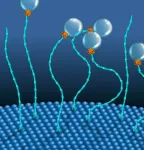(Press-News.org) As Philadelphia strives to meet greenhouse gas emissions goals established in its 2050 Plan, a better understanding of how zoning can play a role in managing building energy use could set the city up for success. Researchers in Drexel University’s College of Engineering are hoping a machine learning model they’ve developed can support these efforts by helping to predict how energy consumption will change as neighborhoods evolve.
In 2017, the city set a goal of becoming carbon neutral by 2050, led in large part by a reduction in greenhouse gas emissions from building energy use – which accounted for nearly three-quarters of Philadelphia’s carbon footprint at the time. But the key to meeting this mark lies not just in establishing sustainable energy use practices for current buildings, but also incorporating energy use projections into zoning decisions that will direct future development.
And the challenge for Philadelphia, one of the oldest cities in the country, is that building types vary widely — as does their energy use. So planning for more efficient energy use at the City level is not a problem with a one-size-fits-all solution.
“For Philadelphia in particular, neighborhoods vary so much from place to place in prevalence of certain housing features and zoning types that it’s important to customize energy programs for each neighborhood, rather than trying to enact blanket policies for carbon reduction across the entire city or county,” said Simi Hoque, PhD, a professor in the College of Engineering who led research into using machine learning for granular energy-use modeling recently published in the journal Energy & Buildings.
Hoque’s team believes existing machine learning programs, properly deployed, can provide some clarity on how zoning decisions could affect future greenhouse gas emissions from buildings.
“Right now there is a huge volume of energy use data, but it’s often just too inconsistent and messy to be reasonably put to use. For example, one dataset corresponding to certain housing characteristics may have usable energy estimates, but another dataset corresponding to socioeconomic features is missing too many values to be usable,” she said. “Machine learning is well equipped to handle this challenge because they can iteratively learn and improve through the training process to reduce bias and variance despite these data limitations.”
To glean information from the disjointed data, the team developed a process using two machine learning programs — one that can tease out patterns from massive tranches of data and use them to make projections about future energy and a second that can pinpoint the details in the model that likely had the greatest effect on changing the projections.
First they trained a deep-learning program, called Extreme Gradient Boosting (XGBoost), with volumes of commercial and residential energy-use data for Philadelphia from the U.S. Energy Information’s Residential Energy Consumption Survey and Commercial Buildings Energy Consumption Survey for 2015, as well as the city’s demographic and socioeconomic data from the U.S. Census Bureau’s American Communities Survey for that time period.
The program learned enough from the data that it could draw correlations between a laundry list of variables, such as density of buildings, population of a given area, building square footage, number of occupants, how many days heating or air conditioning was used, and energy use for each house or building.
While deep learning models like XGBoost are very useful for making informed forecasts, given a large and inconsistent set of data, their methods can be obscured by the complexity of the operations they perform. But to be a useful tool for guiding planners, the team needed to unpack the so-called “black box” program enough to turn its projections into recommendations.
To do it, they employed a Shapley additive explanations analysis, an assessment used in game theory to distribute credit among factors that contributed to an outcome. This allowed them to suss out how much a change in building density or square footage, for example, factored into the program’s projection.
“Machine learning models like XGBoost learn how to chug through datasets to fulfill a specific task — like generating a reliable forecast of a system — but they do not claim to really understand or represent the on-the-ground relationships that underlie a phenomenon,” Hoque said. “And while a Shapley analysis cannot tell us which features have the greatest impact on energy use, it can explain which features had the greatest impact on the model’s energy use prediction, which is still quite a useful piece of information.”
Then the team put the model to the test by providing input data from a hypothetical scenario proposed by the Delaware Valley Regional Planning Commission that estimated continuing economic development in Philadelphia through the year 2045. The scenario suggested a 17% population increase with a commensurate increase in households, and it presents a number of different possibilities for employment and income by region throughout the city.
For each scenario, the model projected how new residential and commercial development would change greenhouse gas emissions from building energy use throughout 11 different parts of the city and which variables played prominent roles in making the projections.
Looking specifically at residential energy use for the 2045 scenario, the program suggested that six of the 11 areas would decrease their energy use – mostly lower-income regions. While mixed-income regions, like the northernmost part of the city, including Oak Lane, would likely see an increase in energy use.
According to the Shapley analysis, the presence of single-family attached (lower energy use) versus detached (higher energy use) dwellings played an important role in the projections, with high monthly electricity cost, lot sizes of less than one acre, and lower number of rooms per building all contributing to lower energy use projections.
“Overall, the residential energy prediction model finds that features related to lower building intensity relate to lower energy consumption estimates in the model, for example lower lot acreage, lower number of rooms per unit,” they wrote. “These results give reason to reinvestigate the effects of upzoning policies, commonly present as an affordable housing solution in Philadelphia and other cities across the U.S., and subsequent changes in energy use for these areas.”
On the commercial side of the scenario, the machine learning model did not project much change in energy use under the 2045 conditions — energy use for the largest commercial buildings remained high. And while it was limited to looking at just six variables — square footage, number of employees, number of floors, heating degree days, cooling degree days, and the principal activity of the building — due to the available data in the training set, the Shapley analysis pointed to building square footage and number of employees as the most important predictors of energy use for most types of commercial buildings.
“With respect to the commercial sector, the study suggests that commercial buildings in the top quantiles of square footage and employee count should be the primary targets for energy reduction programs,” the authors wrote. “The research posits an approximate threshold of 10,000 square feet of total building area, with buildings over that marker being prioritized due to their disproportionate influence on the energy prediction of the model.”
While the researchers caution against assuming a direct link between variables and energy use changes in the model, they suggest that it is still quite useful because of its ability to give planners both a high-level and granular look at the interplay of zoning decisions and development and their effect on energy use.
“I see a lot of potential in using machine learning models like XGBoost to forecast energy use increases or decreases due to new construction projects or policy changes,” Hoque said. “For example, building a new rail line in a neighborhood may change the demographics and employment of a neighborhood, and our methods would be ideal for incorporating that information in the context of an energy prediction model.”
The team acknowledges that more testing is necessary and the program will only improve as it is provided with additional data. They suggest that a next step for the research would be to focus on areas of the city with known high energy use and perform a Shapely analysis to discern some of the factors that could be contributing to it.
“We hope this will provide a resource for future researchers and policy makers so they don’t have to scope through the entire city of Philadelphia, but can hone in on neighborhoods and variables which we have flagged as areas of potential importance,” Hoque said. “Ideally, future studies would use more interpretable methods to test whether these features really correspond to higher or lower energy estimates in a given area.”
END
Machine learning can support urban planning for energy use
Drexel researchers present a machine learning approach for predicting Philadelphia’s future energy use
2023-05-04
ELSE PRESS RELEASES FROM THIS DATE:
University of Toronto researchers use generative AI to design novel proteins
2023-05-04
Researchers at the University of Toronto have developed an artificial intelligence system that can create proteins not found in nature using generative diffusion, the same technology behind popular image-creation platforms such as DALL-E and Midjourney.
The system will help advance the field of generative biology, which promises to speed drug development by making the design and testing of entirely new therapeutic proteins more efficient and flexible.
“Our model learns from image representations to generate fully new proteins, at a very high rate,” says Philip ...
St. Jude tool gets more out of multi-omics data
2023-05-04
(MEMPHIS, Tenn. – May 04, 2023) Despite the astounding advances made in understanding the biologic underpinnings of cancer, many cancers are missing obvious genetic drivers. When scientists can’t pinpoint the factors that drive cancer, treating it can be much more difficult. Scientists at St. Jude Children’s Research Hospital hope to solve that problem with an updated way to analyze multi-omic (primarily transcriptomics and proteomics) data. The researchers created a next-generation computational tool to gain new insights from biological data ...
Alternative fuel for string-shaped motors in cells
2023-05-04
Cells have a fascinating feature to neatly organize their interior by using tiny protein machines called molecular motors that generate directed movements. Most of them use a common type of fuel, a kind of chemical energy, called ATP to operate. Now researchers from the Max Planck Institute of Molecular Cell Biology and Genetics (MPI-CBG), the Cluster of Excellence Physics of Life (PoL) and the Biotechnology Center (BIOTEC) of the TU Dresden in Dresden, Germany, and the National Centre for Biological Sciences (NCBS) in Bangalore, India, discovered a novel molecular system that uses an alternative chemical energy and employs a novel mechanism ...
How seaweed has been misleading scientists about reef health
2023-05-04
For decades, scientists have looked to seaweed as an indicator of the health of coral reefs lying underneath.
But what if the seaweed was misleading them?
New UBC research reveals it was, and scientists need new ways to determine whether human activity is harming a particular reef.
"This is especially critical today, given that reefs globally are threatened by climate-driven stressors,” said Dr. Sara Cannon, a postdoctoral fellow at the UBC Institute for the Oceans and Fisheries and the study's lead author.
Local species ...
CityU researchers develop an additive to efficiently improve the efficiency and stability of perovskite solar cells
2023-05-04
Perovskite solar cells (PVSCs) are a promising alternative to traditional silicon-based solar cells because of their high power-conversion efficiency and low cost. However, one of the major challenges in their development has been achieving long-term stability. Recently, a research team from City University of Hong Kong (CityU) made a breakthrough by developing an innovative multifunctional and non-volatile additive which can improve the efficiency and stability of perovskite solar cells by modulating perovskite film growth. This simple and effective strategy has great potential for facilitating the commercialisation of PVSCs.
“This type of multifunctional ...
Research reveals longstanding cultural continuity at oldest occupied site in West Africa
2023-05-04
Evidence from West Africa about human evolution remains scarce, but recent research has indicated unique patterns of cultural change in comparison to other regions of the continent. A new article in the journal Nature Ecology and Evolution adds to our understanding with a study of the oldest directly dated archaeological site in West Africa. The site shows technological continuity spanning roughly 140,000 years and offers insights into the ecological stability of the region.
Our species emerged in Africa around 300 thousand years ago and ...
A simple antibacterial treatment solves a severe skin problem caused by radiation therapy
2023-05-04
BRONX, NY—May 4, 2023—Acute radiation dermatitis (ARD)—characterized by red, sore, itchy or peeling skin—affects up to 95% of people undergoing radiation treatment for cancer. Severe cases can cause significant swelling and painful skin ulcers that can severely impair quality of life, yet little is known about why this condition occurs and no standardized treatments for preventing severe ARD have been widely adapted.
Researchers at Montefiore Einstein Cancer Center (MECC) have found that many cases of ARD involve a common skin bacterium and that a simple, low-cost treatment ...
Fred Hutch study highlights racial disparities in ovarian cancer risk for women
2023-05-04
SEATTLE, WA — May 4, 2023 — A new Fred Hutchinson Cancer Center study in the journal Obstetrics & Gynecology investigated how endometriosis, uterine leiomyomas (also known as fibroids) and a common intervention for these conditions—hysterectomy—changed ovarian cancer risk in Black and white women.
Scientists found fibroids were associated with an increased risk of ovarian cancer in both Black and white women, with hysterectomy modifying the risk of cancer in both groups. However, researchers also found that while Black and white women with endometriosis had a higher risk of ovarian cancer overall, hysterectomy only ...
Vanishing glaciers threaten alpine biodiversity
2023-05-04
Vanishing glaciers threaten alpine biodiversity
With glaciers melting at unprecedented rates due to climate change, invertebrates that live in the cold meltwater rivers of the European Alps will face widespread habitat loss, warn researchers.
Many of the species are likely to become restricted to cold habitats that will only persist higher in the mountains, and these areas are also likely to see pressures from the skiing and tourism industries or from the development of hydroelectric plants.
The research study – led jointly by the University of Leeds and ...
Neuropathic pain: The underlying mechanism and a potential therapeutic target are revealed in mice
2023-05-04
BIRMINGHAM, Ala. – Neuropathic pain — abnormal hypersensitivity to stimuli — is associated with impaired quality of life and is often poorly managed. Estimates suggest that 3 percent to 17 percent of adults suffer from neuropathic pain, including a quarter of people with diabetes and a third of people with HIV.
In a paper published in the journal Neuron, researchers report that a mechanism involving the enzyme Tiam1 in dorsal horn excitatory neurons of the spinal cord both initiates and maintains neuropathic pain. Moreover, they show that targeting spinal Tiam1 with anti-sense oligonucleotides injected ...
LAST 30 PRESS RELEASES:
Making lighter work of calculating fluid and heat flow
Normalizing blood sugar can halve heart attack risk
Lowering blood sugar cuts heart attack risk in people with prediabetes
Study links genetic variants to risk of blinding eye disease in premature infants
Non-opioid ‘pain sponge’ therapy halts cartilage degeneration and relieves chronic pain
AI can pick up cultural values by mimicking how kids learn
China’s ecological redlines offer fast track to 30 x 30 global conservation goal
Invisible indoor threats: emerging household contaminants and their growing risks to human health
Adding antibody treatment to chemo boosts outcomes for children with rare cancer
Germline pathogenic variants among women without a history of breast cancer
Tanning beds triple melanoma risk, potentially causing broad DNA damage
Unique bond identified as key to viral infection speed
Indoor tanning makes youthful skin much older on a genetic level
Mouse model sheds new light on the causes and potential solutions to human GI problems linked to muscular dystrophy
The Journal of Nuclear Medicine ahead-of-print tip sheet: December 12, 2025
Smarter tools for peering into the microscopic world
Applications open for funding to conduct research in the Kinsey Institute archives
Global measure underestimates the severity of food insecurity
Child survivors of critical illness are missing out on timely follow up care
Risk-based vs annual breast cancer screening / the WISDOM randomized clinical trial
University of Toronto launches Electric Vehicle Innovation Ontario to accelerate advanced EV technologies and build Canada’s innovation advantage
Early relapse predicts poor outcomes in aggressive blood cancer
American College of Lifestyle Medicine applauds two CMS models aligned with lifestyle medicine practice and reimbursement
Clinical trial finds cannabis use not a barrier to quitting nicotine vaping
Supplemental nutrition assistance program policies and food insecurity
Switching immune cells to “night mode” could limit damage after a heart attack, study suggests
URI-based Global RIghts Project report spotlights continued troubling trends in worldwide inhumane treatment
Neutrophils are less aggressive at night, explaining why nighttime heart attacks cause less damage than daytime events
Menopausal hormone therapy may not pose breast cancer risk for women with BRCA mutations
Mobile health tool may improve quality of life for adolescent and young adult breast cancer survivors
[Press-News.org] Machine learning can support urban planning for energy useDrexel researchers present a machine learning approach for predicting Philadelphia’s future energy use







